
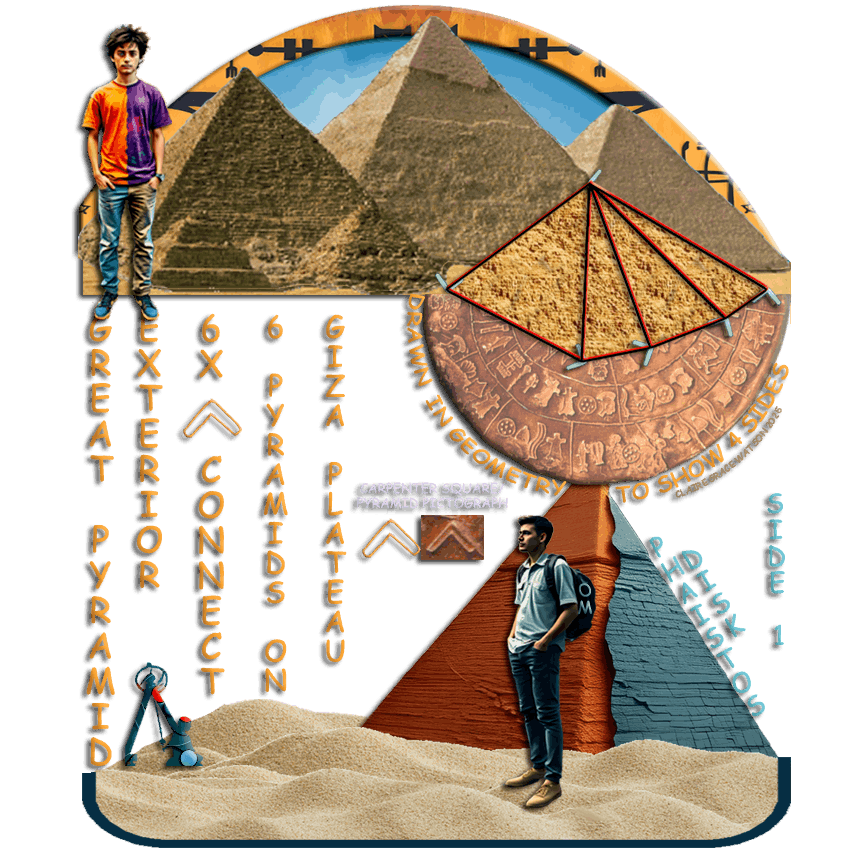

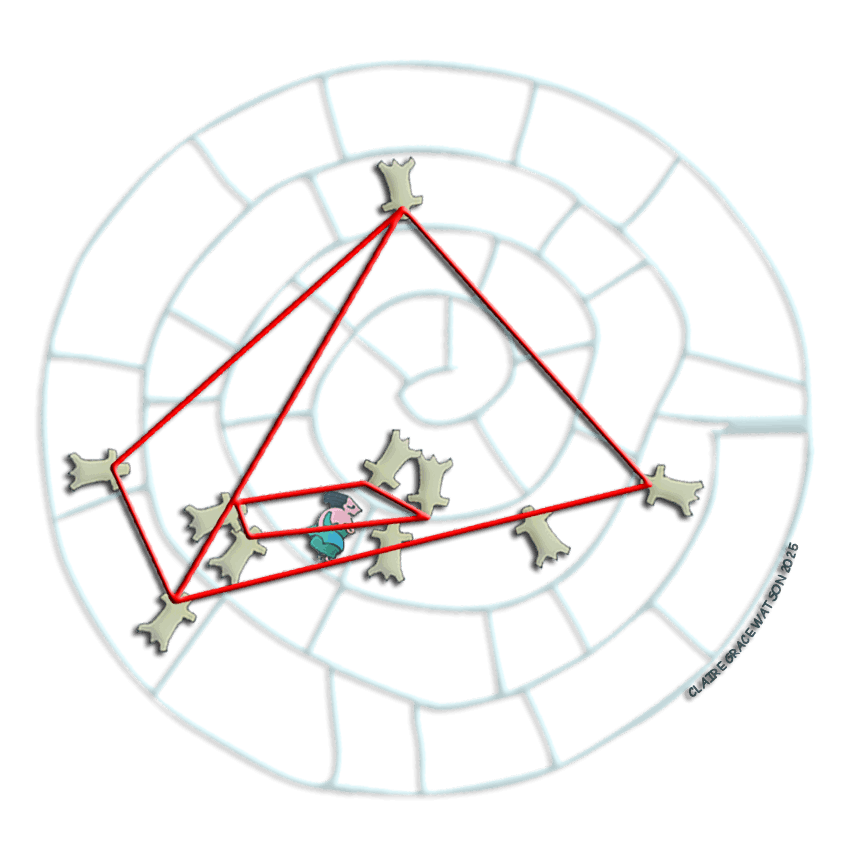
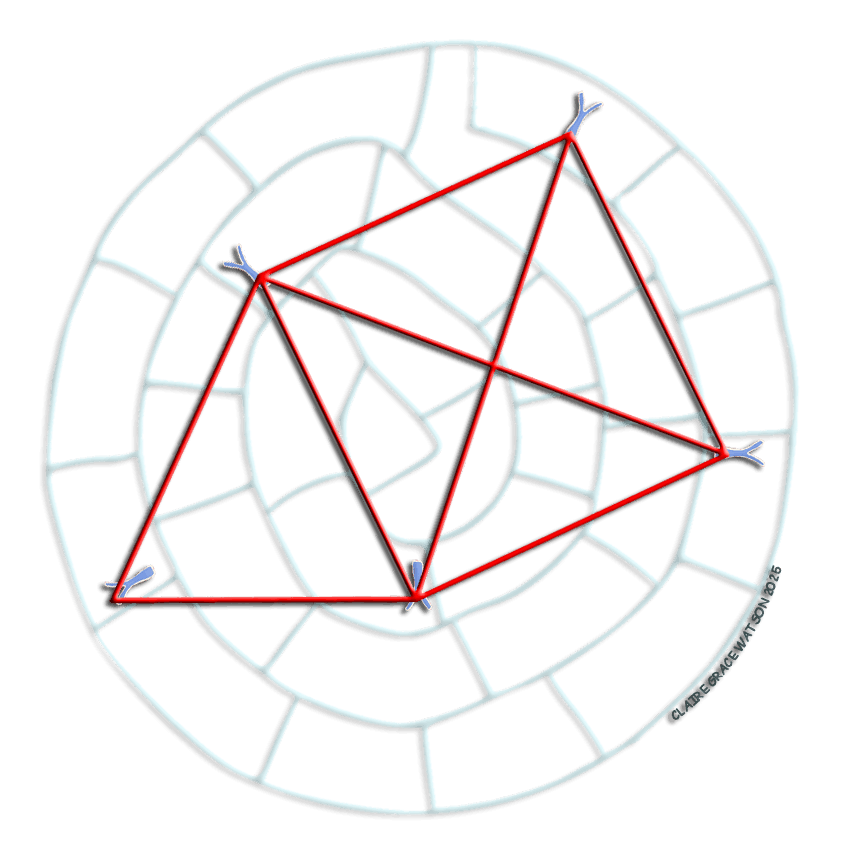
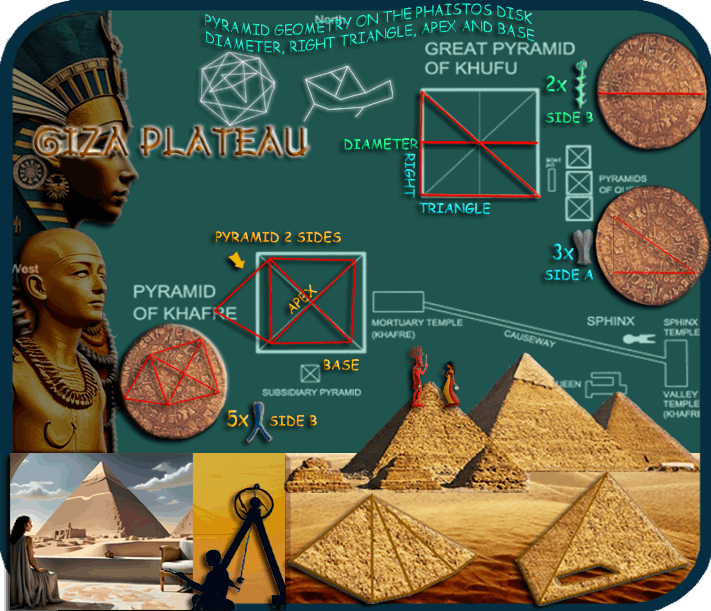
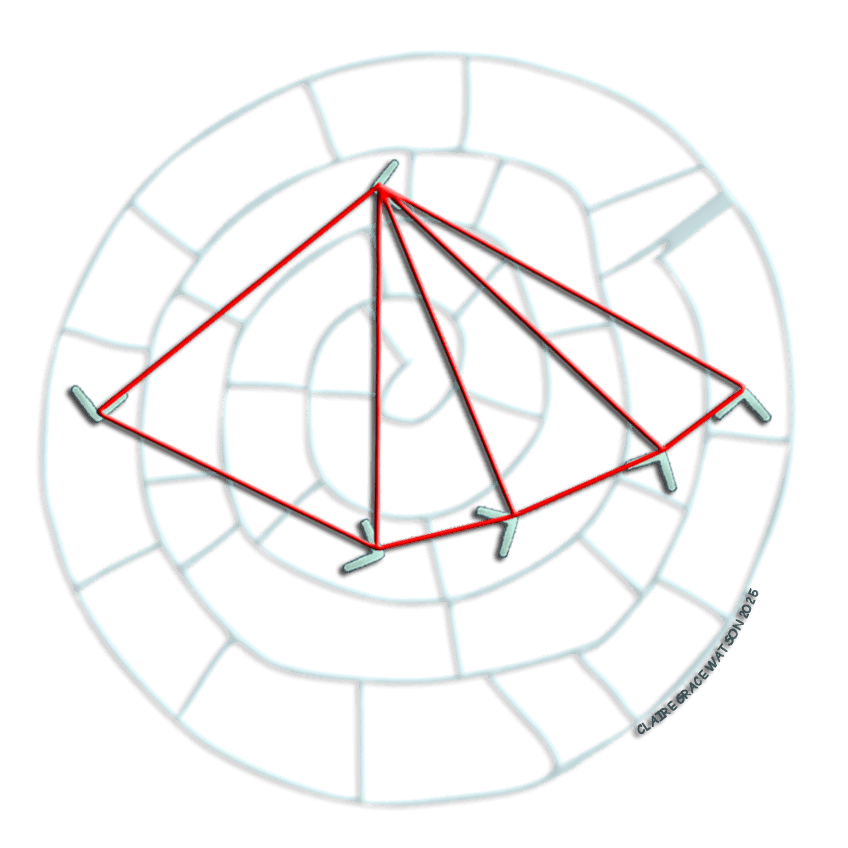 |  | 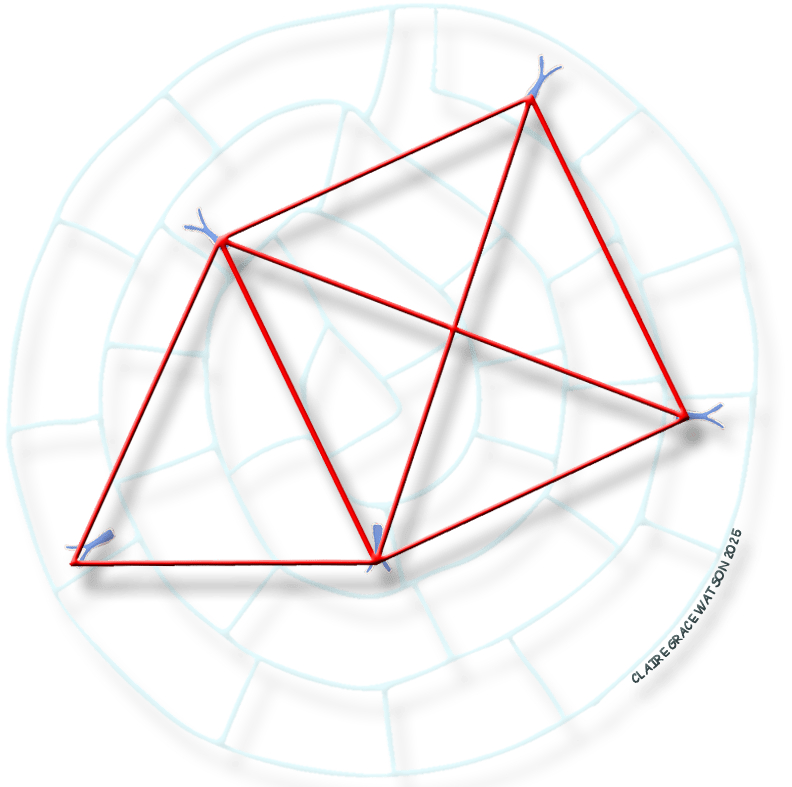 |  | 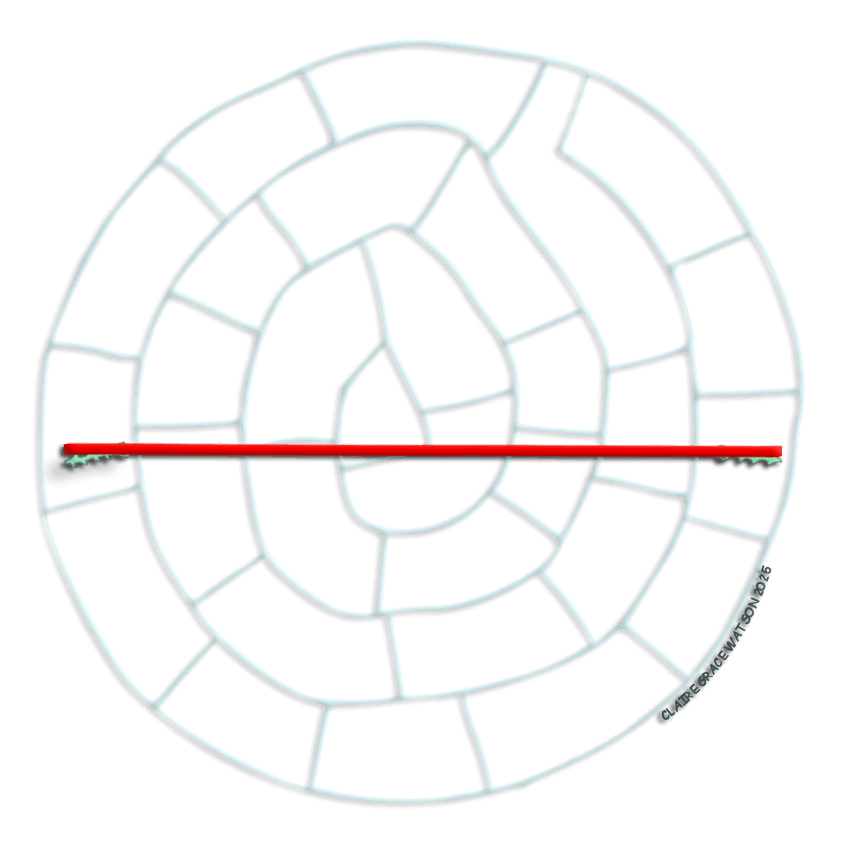 |
Images above from left to right: Great Pyramid Exterior, Great Pyramid Interior, Great Pyramid - Apex, Base, and Two Sides, Right Triangle, Diameter
Phaistos Disk pictographs might relate this ancient Minoan myth. This is the story of how the Curetes saved the god Zeus and became his chosen people. Rhea (left with baby on her lap) entrusted the care of her son to five immortal Curetes, also called Dactyls, meaning fingers (the glove). There are exactly five Dactyl pictographs on the Phaistos Disk. Rhea hid the baby Zeus in a cave on Crete and then invented the Dance of the Labyrinth (Kronou Teknophagia or Crane Dance) to amuse Zeus and to protect him. She surrounded him with warriors banging their shields (the warriors and disk/shield pictograph). Zeus eventually overthrew his hungry father Kronos. Then, Rhea taught the Crane Dance to the Curetes (Cretans), who preserved the tradition and re-enacted the drama in the dance. In this Greek dance, in modern times as in ancient times, the dancers joined hands and one row danced in one direction while the inside row danced in another direction. This might be visualized by this animation of the disk when the warrior signs are connected by lines and the disk is set in motion.
This view of the goddess seems to support the idea that Minoans were at the pyramid to view the goddess, the big star Sirius (right), conceived to be the Goddess Isis-Sothis. My excavation of two pyramids on this disk, one an exterior view and the other an interior view, makes me wonder if there is another pyramid to find, perhaps a view from the top, a prime location to view the goddess. It also encourages me to conclude that the Minoan astronomers and tourists had personal knowledge of the interior of the pyramid, where they went down into the subterranean chamber. Wonder what they did down there, goddess worship?
Minoan cruise ferries today, Anek and Minoan Lines, in Heraklion, Crete, are the result of a 4,000-year evolution of cruise ferries that began in the Bronze Age.
They sailed
Not everyone walked; some were carried in palanquins.
PHAISTOS DISK HIDDEN PICTOGRAPH
How did the Minoans have reliable, safe access to the Great Pyramid? This Egyptian mural portrays Minoans bringing gifts of jewelry, metal, vases, and other treasures, probably to the pharaoh, ca. 1600 BCE. Was the Minoan wealth so abundant that it overflowed their own civilization and greatly enriched the Egyptian world? Even so, they would still need some protection (Warrior perimeter, left) to travel openly into the remote vastness of Egypt, 2,600 years before Cairo was even built.
The Minoans may have included the symbols for the constellations in much of their art and not just on the Phaistos Disk. Is this just an impossibly huge dog on a bead-seal (above) or could it represent the "Great Dog constellation," Canis Major and the "dog star" Sirius?
"The fact of orientation links up with the fact that there early arose a close association between various gods and
the sun and various fixed stars. Whatever mass of people outside were thinking, the priests of the temples were beginning to link the movements of those
heavenly bodies with the power in the shrine. They were thinking about the gods they served and thinking new meanings into them. They were
brooding upon the mystery of the stars. It was very natural for them to suppose that these shining bodies, so irregularly distributed and
circling so solemnly and silently, must be charged with portents to mankind. This clear evidence of astronomical inquiry and of a development
of astronomical ideas is the most obvious, but only the most obvious evidence of the very considerable intellectual activities that went on
within the temple precincts in ancient times. Outside the temples the world was still a world of blankly illiterate and unspeculative human
beings, living from day to day entirely for themselves." (H.G. Wells, The Outline of History)
Today the chorus is singing, "This is the dawning of the Age of Aquarius," but when the disk was created it was the dawning of the Age of Aries from which came the Greek legend of Jason and the Argonauts. It was preceded by the Age of Taurus, supposed to have
been between 4320-2160 BCE (4525-1875, dates vary). An Age, lasting about 2,000 years or so, receives its name from the sign through which the
sun passes year after year as it crosses the equator at the Spring equinox (equal night), when night and day are equal in length all over the world,
each lasting 12 hours on this day.
The idea of the bull-god
is foreign to many of us, although it should not be. Even today in India the bull is sacred, and in Spain and Mexico bull sports are still popular, as are
rodeos in the U.S. In Crete, the bull apparently was at the center of both religion and sport. This history of bull-worship clears up some of the mystery
of the Minoan legend of the Minotaur, a bull-being at the center of the bull sports and the maze. It clears up some mystery about Zeus, the Greek
god who often appeared as a bull. And it also shines some light on the worship of the bull-born Dionysis.
During the Mediterranean Bronze Age, the Aegean people were making a transition from the Age of Taurus and old religion of
bull-worship to the Age of Aries. This was no less a transition from a primitive, idolatrous religion, tied to millenia of Dualism as basic to religious thought, to the beginnings of a scientific-philosophic
world-view and Emantionism and the "One" source of life. The Minoan ascendency over the bull is dramatized perhaps by the bull sports at the center of their festivities.
When the shift comes and the ages change from Taurus to Aries, the worship of the bull is not transferred to the worship of the ram, but instead the worship becomes
a quest for god/dess, who is conceived of in such a way as to be sought after. With the Minoans comes the idea of the Seeker and, for them, as well as for the evolution of consciousness, the Seeker of knowledge is finally the same thing as the Seeker of God/dess.
Perhaps this seeking after the goddess in the sky motivated the development of astronomy in Minoan Crete, with the idea that if we
invent telescopes and binoculars and astronomical measuring devices, we can seek the goddess through seeing her, getting closer to her and
knowing her well. Perhaps this astronomical questing for the divine led to our recognition of the universal powers of time and infinity and
the higher powers of destiny, and to conclusions about such things we might have drawn from stargazing. For the Aegean people, these eternal powers
seemed to emanate from the stars, and it stands to reason that the biggest star, Sirius, must be the most powerful. Therefore, from this star,
an eternal and perfect goddess high in the sky, flow all the gifts in heaven and earth.
With this new power of thought and technological capability comes the wealth, ease and abundance that we associate with the Minoan civilization, a phenomenal flower
that blossomed in the middle of the Aegean Sea. The Greek creation myth tells the story of how it came to pass that the people were so blessed.
It was because the goddess gave them a son--Zeus--who in turn overthrew the old gods. It is not yet the Age of Pisces when the gift is the son of god.
It is the Age of Aries when the gift is the son of goddess.
"I've loved reading your research, it's fascinating. You have a great mind for pictographs!" (Heidi Bosley)
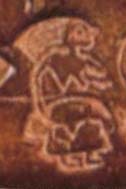 Connecting the 10 identical Golden Fleece signs on Side 1 reveals a second pyramid pictograph that appears to be the interior of the Great Pyramid. At the bottom of this pyramid we see, not the violence of Theseus battling the Minotaur as in the Maze of Daedalus, but a depiction of love and caring, a woman nursing a baby, illumined by the door leading to the lower level. This might be a depiction of the Egyptian goddess Isis or it may be the Minoan version of this goddess, Rhea.
Connecting the 10 identical Golden Fleece signs on Side 1 reveals a second pyramid pictograph that appears to be the interior of the Great Pyramid. At the bottom of this pyramid we see, not the violence of Theseus battling the Minotaur as in the Maze of Daedalus, but a depiction of love and caring, a woman nursing a baby, illumined by the door leading to the lower level. This might be a depiction of the Egyptian goddess Isis or it may be the Minoan version of this goddess, Rhea.
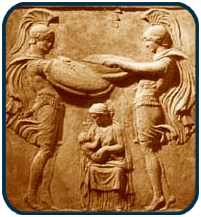 The Phaistos Disk image of Rhea (above left), and the one to the left, bears the influence of the Isis-Osiris mythology in which Isis, after the death of Osiris, feeds the baby Dictys with her finger while with the other hand she beats her
breast in mourning. In Greek/Minoan mythology Great goddess Rhea surrounded her baby Zeus with Warriors beating their shields to drown the cries of the baby so his father Kronos (Time) wouldn't hear him and eat him, as he had all their other children.
The Phaistos Disk image of Rhea (above left), and the one to the left, bears the influence of the Isis-Osiris mythology in which Isis, after the death of Osiris, feeds the baby Dictys with her finger while with the other hand she beats her
breast in mourning. In Greek/Minoan mythology Great goddess Rhea surrounded her baby Zeus with Warriors beating their shields to drown the cries of the baby so his father Kronos (Time) wouldn't hear him and eat him, as he had all their other children.




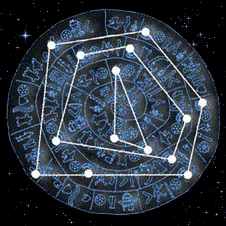 SAILING TO THE GREAT PYRAMID
SAILING TO THE GREAT PYRAMID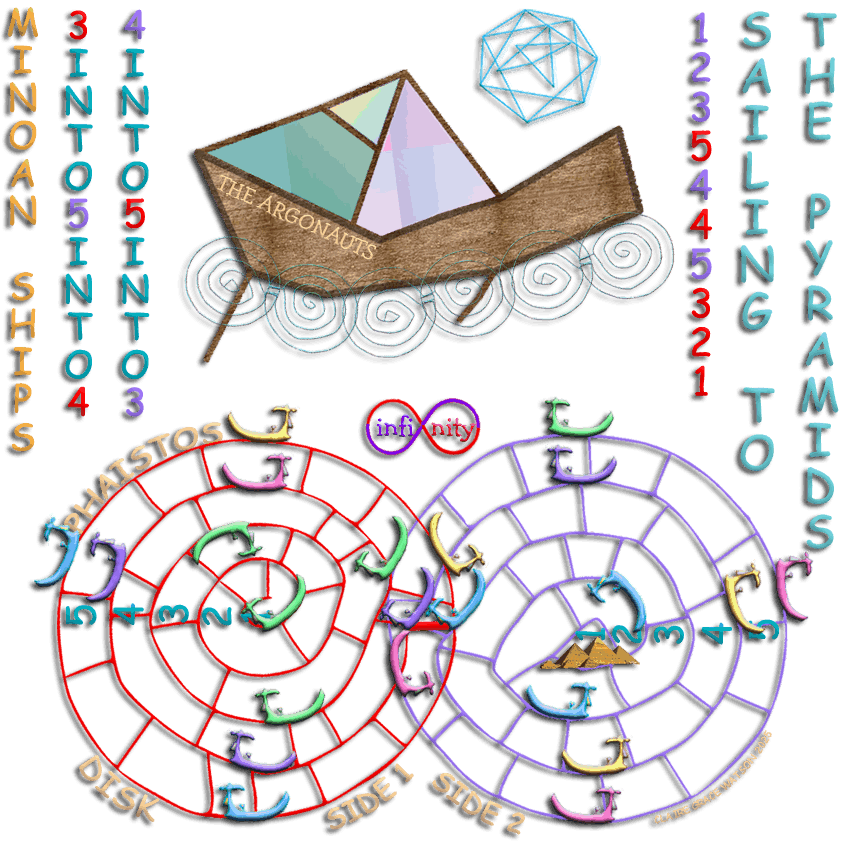
![]()
![]()
![]()
![]()
![]()
![]()
![]()
![]()
![]()
![]()
![]()
![]()
![]()
![]()
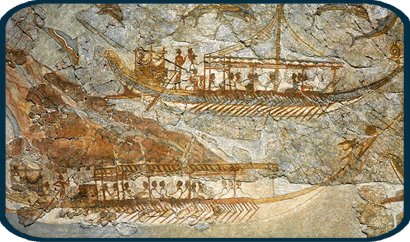 Minoan ferries at Santorini, 1600 BCE
Minoan ferries at Santorini, 1600 BCE
![]() across the Aegean Sea
across the Aegean Sea ![]() to Egypt, continued down the Nile River then walked
to Egypt, continued down the Nile River then walked 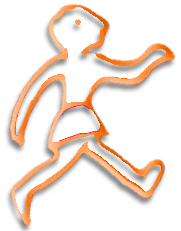 to the Great Pyramid
to the Great Pyramid ![]()


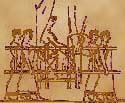
GREAT PYRAMID, EXTERIOR Read the Phaistos Disk
Read the Phaistos Disk
"Carpenter's Squares (geometry)
built the Great Pyramid."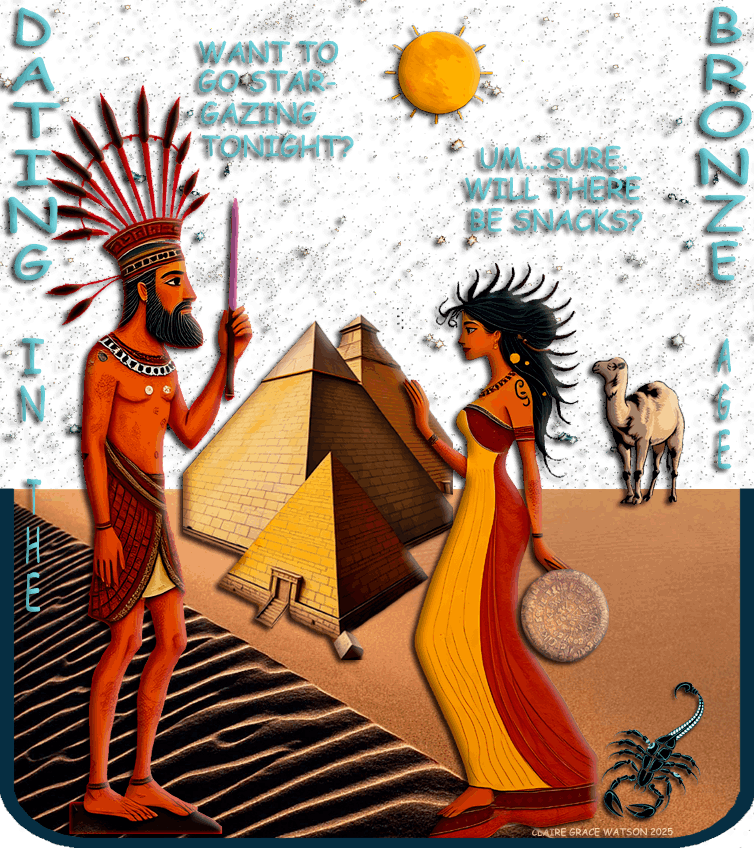
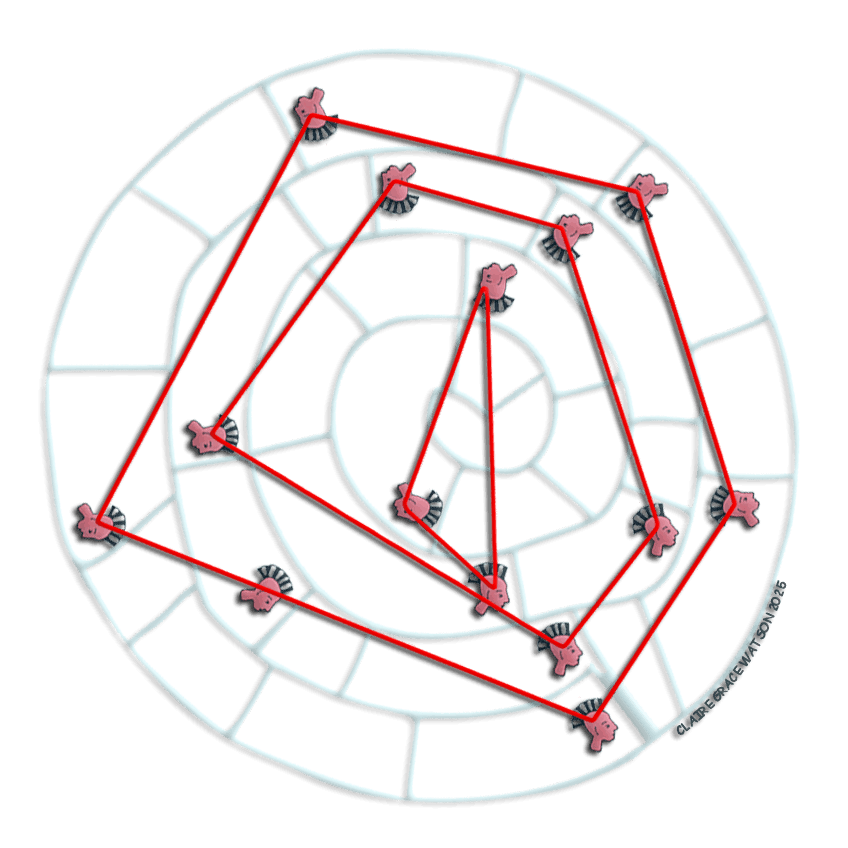 Warrior Perimeter
Warrior Perimeter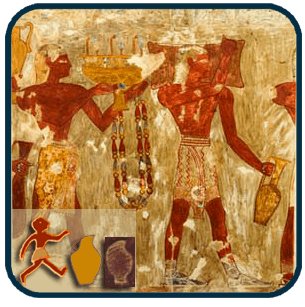 MINOAN SYMBOLS FOR STAR AND CONSTELLATIONS?
MINOAN SYMBOLS FOR STAR AND CONSTELLATIONS?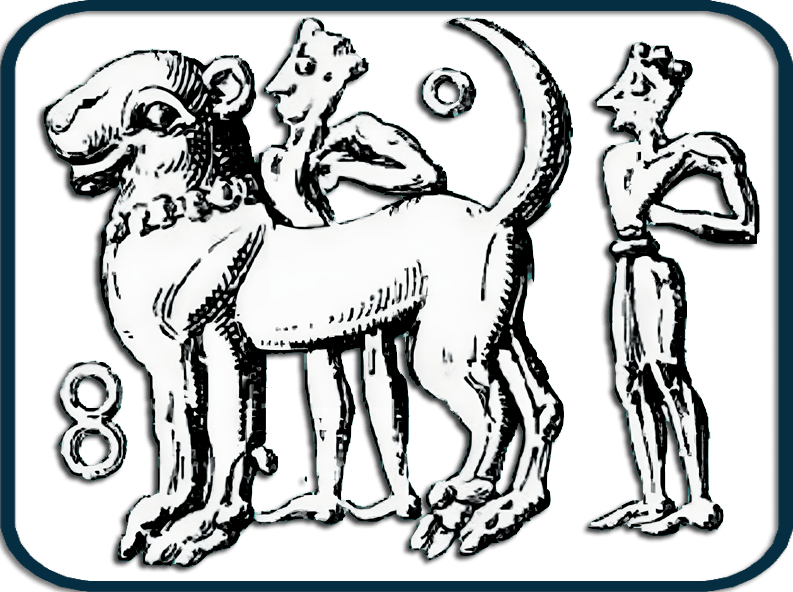 Minoan Cylinder Seal
Minoan Cylinder Seal
![]()
![]() The circle above the great dog could read "star" and the figure 8 symbol to the left, two stars combined, could read "star group" or constellation, in this case Great Dog, Canis Major, with the largest star in the sky, Sirius.
The figure 8 might therefore be a pictograph for constellation, logically so because the stars are infinite, and we might also use it as a clue to the solution of the Phaistos Disk maze puzzle.
The circle above the great dog could read "star" and the figure 8 symbol to the left, two stars combined, could read "star group" or constellation, in this case Great Dog, Canis Major, with the largest star in the sky, Sirius.
The figure 8 might therefore be a pictograph for constellation, logically so because the stars are infinite, and we might also use it as a clue to the solution of the Phaistos Disk maze puzzle. 
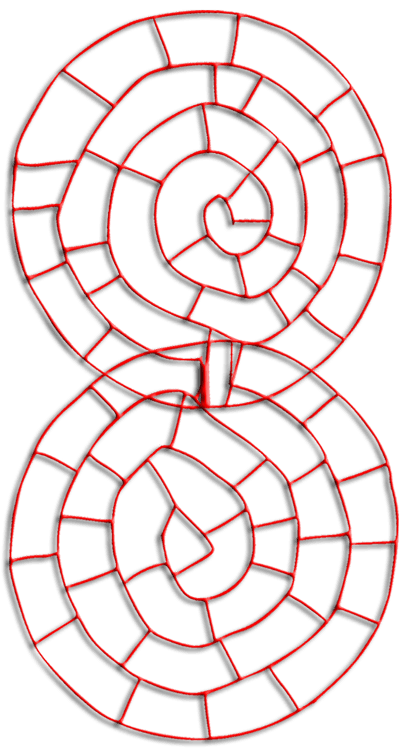 If it is a sign for constellation, this would make the maze puzzle solution even more a-mazing! The solution would be their symbol for constellation and a validation that many of the geometries contained by the Phaistos Disk are indeed constellations. It would mean the two sides of the Phaistos Disk, individually, represent "star," and connected together they represent "star group" or constellation. So, the Phaistos Disk would have been an attempt to preserve all the constellations the Minoans had identified, a subject and effort worthy of a pottery art masterpiece, I think :) (Phaistos Disk left, pictographs removed)ASTRONOMICAL AGES, BULL WORSHIP, AND THE MINOTAUR
If it is a sign for constellation, this would make the maze puzzle solution even more a-mazing! The solution would be their symbol for constellation and a validation that many of the geometries contained by the Phaistos Disk are indeed constellations. It would mean the two sides of the Phaistos Disk, individually, represent "star," and connected together they represent "star group" or constellation. So, the Phaistos Disk would have been an attempt to preserve all the constellations the Minoans had identified, a subject and effort worthy of a pottery art masterpiece, I think :) (Phaistos Disk left, pictographs removed)ASTRONOMICAL AGES, BULL WORSHIP, AND THE MINOTAUR Overlighting this early human fascination with number and geometry were the stars, and perhaps their participation was not passive at all. There is the possibility of human brain embeddedness of starlight (left), which could account for the enlightenment, development, and expansion of human consciousness. We do not have to concede this intimate relationship with the stars to continue this theory of Minoan astronomy, but we do concede the contribution the stars make in the form of the astronomical ages.
Overlighting this early human fascination with number and geometry were the stars, and perhaps their participation was not passive at all. There is the possibility of human brain embeddedness of starlight (left), which could account for the enlightenment, development, and expansion of human consciousness. We do not have to concede this intimate relationship with the stars to continue this theory of Minoan astronomy, but we do concede the contribution the stars make in the form of the astronomical ages. ![]()
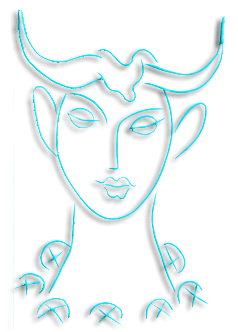 In the Age of Taurus the bull was worshipped as divine. After
perhaps as many as 25,000 preceding years of bull worship, it is not surprising that the bull figured significantly in the Minoan civilization. A bull's
foot appears twice on the Phaistos Disk (left). Egypt had its Serapis, the sacred Osiris-Apis bull. Baal was widely worshipped,
later on the Israelites had their golden calf Moshe (Moses), and painted on the walls of buildings in ancient Sumer are humans with horns. The horns tell
of their status as gods and goddesses. (Minoan Queen Pasiphae drawn by Picasso, right)
In the Age of Taurus the bull was worshipped as divine. After
perhaps as many as 25,000 preceding years of bull worship, it is not surprising that the bull figured significantly in the Minoan civilization. A bull's
foot appears twice on the Phaistos Disk (left). Egypt had its Serapis, the sacred Osiris-Apis bull. Baal was widely worshipped,
later on the Israelites had their golden calf Moshe (Moses), and painted on the walls of buildings in ancient Sumer are humans with horns. The horns tell
of their status as gods and goddesses. (Minoan Queen Pasiphae drawn by Picasso, right)![]()
![]() In the Age of Aries the bull-god
gives over to the ram, whose Golden Fleece is the object of the quest of Jason and the Argonauts. They stopped worshipping the bull - in fact, they slayed
the bull in Crete, or Theseus did, in the legend of Theseus and the Minotaur. Following the Age of Aries is the Piscean Age in which a divine fish
symbolizes the Son of God as the "fisher of men." As we move into the Age of Aquarius, the cup is the symbol of the divine and holds the Water of Life, and
the Knights of the Round Table quest for the Holy Grail. One way or another, either directly or indirectly, we are influenced by the stars. Are they
really eternal powers? The Minoans apparently believed so.
The Puzzle | Maze of Daedalus | Constellation Argo
In the Age of Aries the bull-god
gives over to the ram, whose Golden Fleece is the object of the quest of Jason and the Argonauts. They stopped worshipping the bull - in fact, they slayed
the bull in Crete, or Theseus did, in the legend of Theseus and the Minotaur. Following the Age of Aries is the Piscean Age in which a divine fish
symbolizes the Son of God as the "fisher of men." As we move into the Age of Aquarius, the cup is the symbol of the divine and holds the Water of Life, and
the Knights of the Round Table quest for the Holy Grail. One way or another, either directly or indirectly, we are influenced by the stars. Are they
really eternal powers? The Minoans apparently believed so.
The Puzzle | Maze of Daedalus | Constellation Argo
Star Sirius | Cheops Pyramid | The Pictographs
Author | Home | Previous Page | Next Page![]() Unpacking and publishing the Phaistos Disk since 1993
Unpacking and publishing the Phaistos Disk since 1993 Copyright Notice - Disk of the World - Text and images copyrighted March 21, 1993-2025, Claire Grace Watson, B.A., M.S.T., U.S. Copyright and under the Digital Millennium Copyright Act of 1998, All rights reserved. No part of this web page may be reproduced or transmitted in any form or by any means without written permission from the author, except for the inclusion of brief quotations in a review.
Copyright Notice - Disk of the World - Text and images copyrighted March 21, 1993-2025, Claire Grace Watson, B.A., M.S.T., U.S. Copyright and under the Digital Millennium Copyright Act of 1998, All rights reserved. No part of this web page may be reproduced or transmitted in any form or by any means without written permission from the author, except for the inclusion of brief quotations in a review.